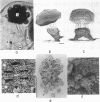Abstract
It is readily apparent upon examination and comparison of organisms of the same and related species that to a large extent genes control morphological features. One means to ascertain the role and degree of genetic control is to study in detail the anatomy and development of a particular structure, say an identifiable neuron, in a population with a fixed genome, and at different stages of morphogenesis. The small crustacean, Daphnia, is well suited for this type of study, since it reproduces parthenogenically, its development is easily staged, and its nervous system is reasonably simple. In this paper comparisons of detailed morphology of neurons in the visual system of adult Daphnia magna are considered. Results indicate that gross features of the system are reproduced within the clone, but some of the finer details are not reproduced.
Keywords: neuronal specificity, serial section reconstruction, crustacea
Full text
PDF




Images in this article
Selected References
These references are in PubMed. This may not be the complete list of references from this article.
- SAGER R., GRANICK S. Nutritional studies with Chlamydomonas reinhardi. Ann N Y Acad Sci. 1953 Oct 14;56(5):831–838. doi: 10.1111/j.1749-6632.1953.tb30261.x. [DOI] [PubMed] [Google Scholar]
- Wolff J. R., Güldner F. H. Uber die Ultrastruktur des "Nervus opticus" und des Ganglion opticum I von Daphnia pulex. Z Zellforsch Mikrosk Anat. 1970;103(4):526–543. [PubMed] [Google Scholar]



